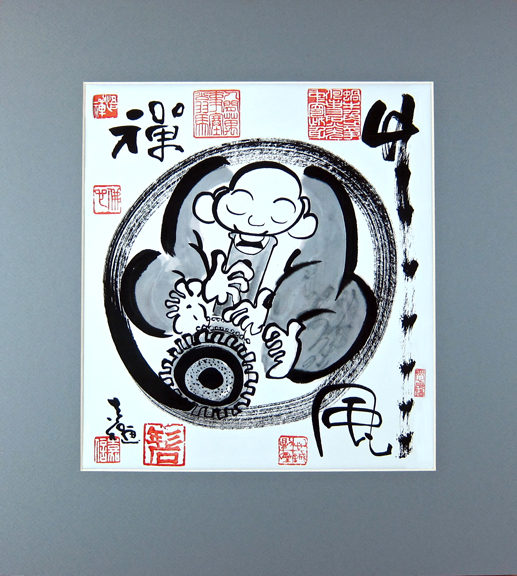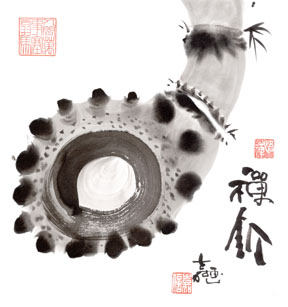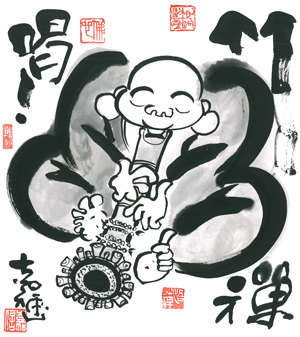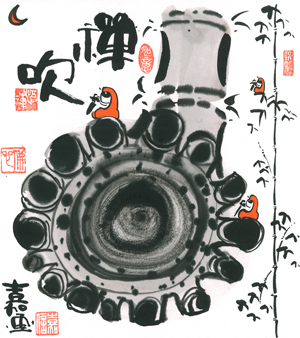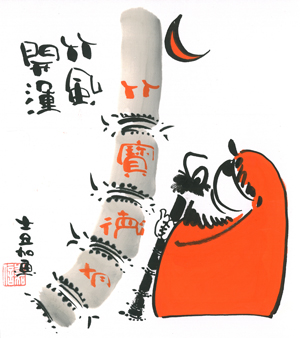Shakuhachi Sumi-e Paintings Yoshinobu HOME PAGE
|
|
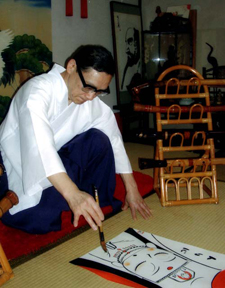
|
Yoshinobu RyudoTaniguchi Shakuhachi Master Yoshnobu Taniguchi is one of the foremost living masters of shakuhachi in Japan today. In addition to having studied under three great pillars of shakuhachi - Aoki Reibo, Yamaguchi Goro and Yokoyama Katsuya - he has also mastered the playing styles and repertoire of many other shakuhachi sects.Taniguchi is a recipient of the transmission of Koden Honkyoku through Watazumido Shuso and Yokoyama Katsuya. He has received several honors for his work in Japan including acknowledgement as top performer at the Osaka Geijutsu Sai. He was also given the honorary title of Sen Shin Kutsu Dai Shihan at the young age of 32, a title usually reserved for senior "ambassadors" of shakuhachi. Taniguchi-sensei was Visiting Professor of Shakuhachi at Oberlin College Conservatory of Music in Oberlin, Ohio where he taught in 1982. He presently resides in Mineyama-cho, a small city near the Sea of Japan outside of Kyoto. Despite widespread recognition as a master of the shakuhachi, Taniguchi shuns the spotlight, preferring to focus on his personal training and preparations for a few select performances each year. Sumi-e Artist His deep commitment and lifelong practice of Zen Buddhism are manifested in his art, and embodied in his work with shakuhachi and traditional Japanese sumi-e ink brush painting. He is the decendant of a long line of Zen monks on both sides of his family. Taniguchi's father came from Niigata Prefecture, near where his distant relative, the Zen saint Ryokan (1758-1831), a renouned poet and calligrapher, took up residence in a hermitage he named Gogo-An at Kokujoji Temple on Mt. Kugami. A monk of the Soto sect of Zen Buddhism, Ryokan's calligraphy and haiku poems are known and admired throughout the world. Taniguchi's great grandfather on his mother's side was Byakuho-Ryoukoh, head monk of Eiheijji temple. Despite this prominent lineage, Taniguchi is self-taught as a sumi-e artist. He once told me that the ideas and themes that inspire his paintings come at night, when the events of daily life calm down and all is quiet. He begins by sitting and making the ink, but soon an undescribable energy force erupts. His sumi-e are not intentional, but a manifestation of this force. Some nights, he draws many paintings in a short period of time with no apparent effort as the inspiration flows through him. It is my great honor to offer reprints of Yoshinobu RyudoTaniguchi's wonderful shakuhachi—and Zen Buddhist-themed sumi-e prints for the very first time. Pictured below of just some of his remarkable works of art arranged by subject. The will be more to follow. |
SHAKUHACHI SUMI-E PRINT CATALOGS |
|||
CATALOG |
THEME |
PRINT # |
|
Shakuhachi Sumi-e Prints Availalbe matted or unmatted. Image size of all prints are 9 1/2" wide x 10 3/4" (242 mm. x 274mm.), same dimensions as the original artwork. Overall size of matted prints are 14 3/4" x 16 1/4" ( 375 mm. x 413 mm.) Price breaks avaialble for orders of multiple prints. See Price List for Sumi-e Prints. All the reprints on this web site are the work of Yoshinobu RyudoTaniguchi. Copyright 2014. All rights reserved. |
